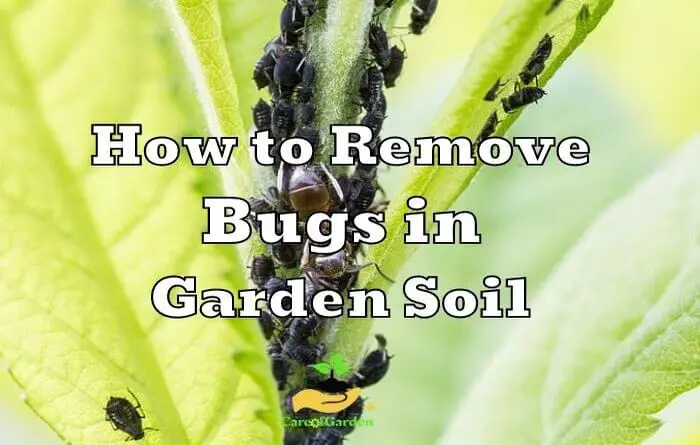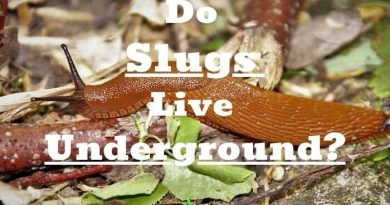How to Get Rid of Bugs in Garden Soil [12 Unique Ways]
As always, prevention is also the most effective weapon against plant parasites : just recognize them and flush them out quickly before it’s too late. Let’s see how to do this and which are the safest and most ecological do-it-yourself method how to get rid of bugs in garden soil.
Among pests , molds , insects , fungi , mites and dozens of little creatures that can seriously compromise the health of the garden soil, the danger is always lurking.
They are often so small that they are invisible . They silently strike some parts of the plant and then affect the entire structure and if you do not intervene quickly with the right solutions, they can be lethal.
Instead of resorting to pesticides, insecticides and other chemicals that are harmful to both our health and that of plants, you can try some very reliable natural remedies.
| Type of Bugs in Garden Soil | Methods to Get Rid of Bugs in Garden Soil |
|---|---|
| 1. Aphids | 1. Using Detergent and soft soap 2. Using Garlic |
| 2. Fungus gnats | 1. Using Baking Soda 2. Using Fruit Juice |
| 3. Spider Mites | 1. Using Onion 2. Using Cold Water |
| 4. Mealybugs | 1. Using Soap 2. Using Nettle-Water Mix |
| 5. Scale Bugs | 1. Using Nettle 2. Using Oregano |
| 6. Whitefly | 1. Using Onion 2. Apple Cider Vinegar |
How to Get Rid of Aphids Bugs in Garden Soil
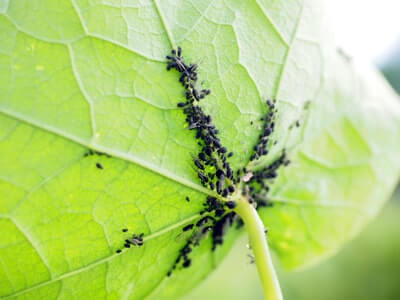
The aphids are one of the most common bugs that damage plants and garden soil. In science they are also called tube aphids and, like scale insects, mealybugs and whitefly, belong to the group of plant lice.
After they take a break in winter, they appear more and more in spring. With their tiny wings, they do not stop in front of many plants.
The small proboscis of the aphids attack the plant cells of the young leaves directly. As a result, they suck out the nutritious, sugary plant sap and weaken the plant extremely or make it more susceptible to diseases.
Here are 4 methods how to get rid of aphids bugs in garden soil:
1. Using Detergent and soft Soap
Dissolve detergent / soft soap in the water. Then spray the plant making sure that the solution does not get on the soil. You can then wipe off the aphid infestation with a cloth. Repeat several times.
2. Using Garlic
One of them is to leave three heads of garlic in a liter of water for a day in a covered container.
Then we pour this water into the spray bottle and spray the affected garden soil, stems and flowers for seven days in a row.
3. Rapeseed Oil
The mixing ratio for the water-oil emulsion is 70% water and 30% oil. You can use the spray bottle to apply the water-canola oil mix to the parts of the plant and garden soil.
4. With Nettle Liquid Manure
You need blooming nettles for the liquid manure. You should ferment one kilo of the herb in about 10 liters of water for one to two weeks.
Then you always dilute one liter of the nettle liquid manure with ten liters of water. Spray your infested plant with it every two weeks.
How to Prevent Aphids Infestation in the Garden
Tricks you can use to prevent aphid infestation:
- eliminate weeds, as aphids tend to lay eggs there;
- protect crops, especially young ones, with insect nets ;
- avoid leaving piles of cut grass or crop leftovers.
Tip 2: Place a lavender plant or savory next to your other houseplants. The essential oils of these plants do not like the aphids at all.
Tip 3: Fertilizing with synthetic fertilizers often leads to incorrect fertilization (too much nitrogen in the soil). Therefore, avoid this and use biological remedies.
How to Get Rid of Fungus gnats Bugs in Garden Soil
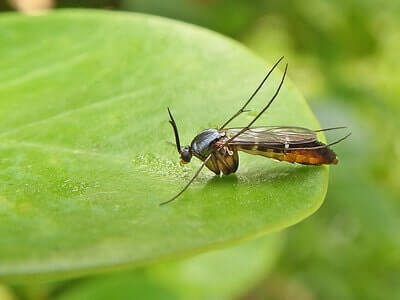
The fungus gnats, which are between 4-7 mm in size, are often mistaken for fruit flies. A big difference, however, is the location: while the fruit flies are always close to rotten fruit and leftover food, the sciarid gnats prefer plants and moist soil in the flower pots.
It is not the mosquito that causes the damage to the plant, but its larva. They are mainly found in the potting soil, as they feed on the roots and dead plant debris.
You can fight the fungus gnat infestation not only with chemical, but also with biological means. This should always be preferred over chemical agents.
Here we show you three ways how to remove fungus gnats in garden soil:
1. With Baking Soda
Baking soda is a pure miracle cure as it fights many insects. The fungus gnats are also sensitive to baking powder. An ideal home remedy.
Sprinkle a little baking soda on the garden soil and then moisten it. The larvae that are in the ground absorb the baking powder and die over time.
2. Using Fruit Juice
Like most insects, fungus gnats love sugar. Purchased fruit juices often contain a lot of sugar, which is a magical attraction for the animals.
Simply place a glass filled with fruit juice next to the infested plant overnight. You can carry out this method over several weeks and after a certain time you will notice that it has minimized the population of sciarid gnats.
3. Coffee
You can also use coffee to combat the fungus gnat larvae that have settled at the root .
Dilute about half a cup of cold coffee 1: 1 with water and pour it over the garden soil. The larvae cannot tolerate the caffeine and die.
However, not all plants tolerate the caffeine either. You should therefore only use the home remedy sparingly and over a short period of time.
4. With Parsley
What sciarid gnats don’t like at all is parsley. So just spread a little chopped parsley on the potting soil. The fungus gnats stay away from the plant in no time.
How to Prevent A Fungus gnats Infestation in the Garden
There are a few things you can do to ensure that fungus gnats are not attacked in the first place. So you don’t even have to declare war on the sciarid gnats and their larvae.
Tip 1: Always make sure that the soil in your houseplant is not too moist, because that is exactly what the fungus gnats like. Therefore, you should possibly also change the watering behavior.
Always water when the upper layer of soil has dried up. In addition, there should be no water in the flower pot.
Tip 2: If you have to repot your infested plant, then clean the old flower pot very thoroughly, as the sciarid mosquito larvae tend to settle there.
Tip 3: Unfortunately, fungus gnats can also get into your home through freshly bought soil. The animals like to sit in cheap soil, in particular. Therefore, always pay attention to the quality when buying new potting soil.
How to Get Rid of Spider Mites in Garden Soil
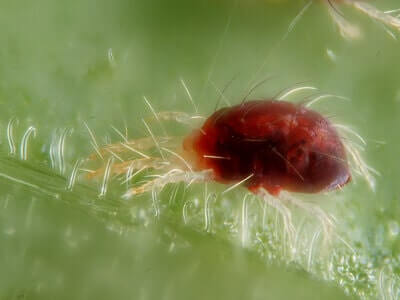
Spider mites become a problem for plants, especially in winter, as they feel super comfortable in the dry heating air. It usually doesn’t take long for the 0.5 cm spider mite to make itself comfortable on your houseplants.
As soon as you recognize an infestation, you should not hesitate long, but act. You can get rid of spider mites in a garden soil with these 3 home remedies:
1. Onion-Water Mix
For the brew, soak dry onion skins (optionally together with garlic skins) in water overnight. The next day, strain the water and spray it on the affected soil and plant. For this method to be effective, you should apply it over several days.
2. Cold Water
A cold shower should also help. To do this, place the plant in the bathtub / shower and wash it off with the shower head. This is how you can remove the spider mites that are sitting on the leaves. If there are spider mites in the garden soil, you should definitely repot the plant and use new soil.
Hunt red spiders by soaking the underside of the leaves of your plants with a mixture of water, cigarette ends and a spoonful of denatured alcohol (6 cigarette ends per liter of water).
3. Using Plastic Wrap
Cover the affected plant with plastic wrap (cling film) (this is of course only possible with smaller plants), if possible so that little air can get to the plant. Leave the foil on the plant for about ten days. This increases the humidity and the spider mites gradually die.
4. Using Acaricides
If the stage is too advanced, it will be necessary to resort to a specific acaricide, (but beware, red spiders have developed resistance to certain chemical treatments, it is therefore advisable to alternate the active substances).
How to Prevent Spider Mites Infestation in the Garden Soil
Since spider mites feel very comfortable on your plants, especially in the winter months, you should pay attention to the right care here.
Tip 2: Avoid dry heating air in the rooms.
Tip 3: Spray the plant regularly with a little water so that it doesn’t dry out easily.
How to Get Rid of Mealybugs in Garden Soil
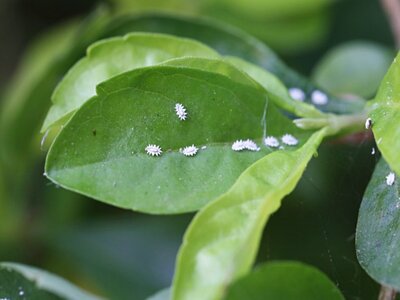
The mealybugs form a subfamily of the scale insects. These include around 1,000 species. The animals are between one and twelve millimeters in size and occur all over the world. In Central Europe, however, the citrus mealybug and the long-tailed mealybird are most common.
The females can lay up to 600 eggs on the leaves or soil of the plant approximately every two months. After 10 days the time has come: the larvae hatch from their eggs and unfortunately spread rapidly.
Here we introduce you to three remedies against mealybugs. You may already ideally have some of the home remedies at home. If not, that’s no problem either, because you can easily get these things in the supermarket or in the garden center.
1. With Garlic
A proven remedy against mealybugs is the garlic brew. To make this home remedy, you must first chop 50 g of fresh garlic very finely. Then pour 1.5 liters of boiling water over it. Let the brew stand for about 30 minutes.
Then you can pour it through a sieve. When the brew has cooled down, you can use a spray bottle to apply it to the infested plant and garden soil.
2. Using Soap
Dissolve 2 tablespoons of soap or curd soap in one liter of water. Then you can moisten a rag with the solution and wipe the infected plant with it. Alternatively, you can also put the solution in a spray bottle. Always make sure that the agent does not get onto the soil in the pot.
3. Using Nettle-Water Mix
For the brew you should pour 1 kg of fresh nettles in a container with 10 liters of boiling water. You should now let the covered container steep for three days (preferably stir once a day).
Then you can pour the brew through a sieve as with horsetail and pour it into a spray bottle with which you can spray the affected parts of the plant.
How to Prevent Mealybugs Infestation in the Garden Soil
Unfortunately, the mealybugs often appear with incorrect care or incorrect location conditions. That is why it is all the more important to pay special attention to it.
Tip 1: Dry air and a location that is too warm or too dark promote infestation by mealybugs. So keep this in mind when choosing the location for your plant.
Tip 2: Always make sure that your apartment is well ventilated and avoid dry heating air.
Tip 3: Always follow the instructions on the fertilizer exactly. The mealybugs feel very comfortable in soil that is over-fertilized with nitrogen.
How to Get Rid of Scale Bugs from Garden Soil
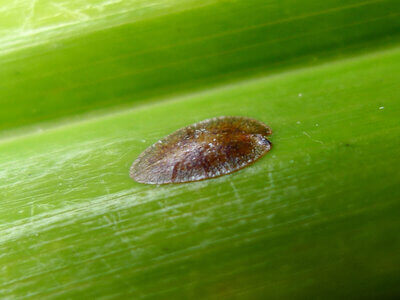
Scale bugs infest both useful and ornamental plants and are therefore found outdoors, but also in your home. The up to six millimeters large animals owe their name to their waxy shield, which can reach two millimeters in diameter.
The females have a proboscis with which they suck up the shoots, petioles and leaves of a plant. This removes valuable nutrients from the plant. Depending on the species, the scale insects can also release poison into the plant in addition to sucking, or they produce honeydew like the aphids.
This in turn is an ideal breeding ground for certain types of mushrooms. This puts a double burden on the plant.
1. Using Nettle
Use either 200 g of fresh nettles or 20 g of dried leaves. Chop them up and pour cold water over them. You should then let the mixture steep for about eight hours. Then pour the mixture through a sieve to catch the leaves and use a spray bottle to spread the solution over the affected plant.
2. Oregano
In addition to the nettle herb, oregano from the garden can also help. For the solution you have to add 100 g of fresh oregano, alternatively 10 g of dried oregano, with one liter of boiling water. After 15-20 minutes you can pour the brew through a sieve. However, you should always apply the brew diluted with water in a ratio of 3: 1 to the plant using a spray bottle.
3. With Garlic
You can either stick a clove of garlic in the ground or make a garlic brew, which is more effective. For the production you need 50 g fresh chopped garlic, which you pour 1.5 L boiling water over.
You should let the brew steep for at least 30 minutes so that the active ingredients of the garlic unfold perfectly. Then you can put the cooled mixture, poured through a sieve, into a spray bottle and spray on the affected parts of the garden soil.
How to Prevent Scale Bugs Infestation in the Garden Soil
Especially in winter you should regularly check your plants for infestation. The condition of the plant is crucial to whether the pests get comfortable on it or not. And you can influence the condition with proper care.
Make sure that your plant gets enough light even in winter and does not suffer too much from dry heating air. In addition, heavy chemical nitrogen fertilization has a negative impact on the health of your plant. Therefore: stay away from chemical fertilizers that contain too much nitrogen!
How to Get Rid of Whitefly Bugs in Garden Soil
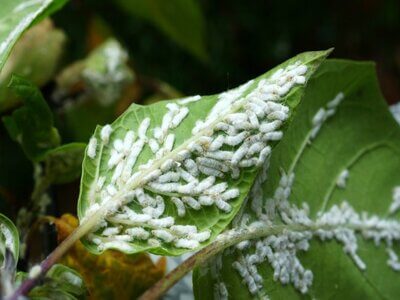
The whitefly is a plant parasite of tropical origin . Its favorite victims are lemon plants , but it does not disdain balcony and garden flowers , such as begonias , orchids and geraniums. A bit like the cochineal it prefers warm and humid environments, so it is very easy to find it in lake areas and greenhouses.
Another of the usual when it comes to eliminating pests from the garden. It is easily recognized because its color stands out on the leaf, but also because of the discolorations it leaves on the leaves it devours.
With a working method similar to the aphid, since despite being called a fly it is a bed bug, it takes advantage of the underside of the leaves to lay its eggs. It also feeds on sap and, like the mealybug, leaves a viscous and potentially nutritious trail for fungi.
The above-described remedy based on onion water mix is also described as valid, which will be macerated at a rate of 250 grams in a liter of water for eight days.
Another remedy is to put a pot with marigold flowers near the affected plants , which are available in most florists, and there are those who recommend growing basil or even spraying this plant with leaf water.
Another means of control without chemical insecticides is the trapping of whitefly bugs adults: place near the affected plant small sticky yellow cardboard plates (coated with glue or honey), or even yellow adhesive tapes. The adult whiteflies, attracted by the yellow color, will abandon the leaves and stick to these traps.
There are two drawbacks to this method: on the one hand, it can only be envisaged at the start of an infestation, and it will undoubtedly be insufficient if the white flies are very numerous. On the other hand, it is not selective and you risk seeing ladybugs , bees and other auxiliary insects sticking to the traps.
Here is an helpful guide how to prevent yellow leaves on Kalanchoe plant!
Tips How to Get Rid of Bugs in Garden Soil
1. Use a Quality Soil
The main recommendation is to use professional and high quality soil . Sometimes it seems absurd to have to buy a more expensive product, even if the difference is not abysmal, but the choice of a good soil saves us from many other problems that could arise and which, in the end, would lose a greater expenditure in time and money, as well as the fundamental aspect of the health of our plants.
2. Combine the right plants to protect your garden soil
Some plants protect each other from all the insects that are harmful to them and can decrease the risk of disease, they are called companion plants.
Knowing this kind of plant associations is an essential asset to take care of your garden naturally. A table exists and indicates which vegetables are compatible or not.
We learn for example that garlic when combined with carrots, beets or strawberries repels insects.
3. Focus on auxiliary insects
Not all insects are necessarily harmful to your garden soil, and for proof! Have you ever heard of helper insects?
The ladybug, lacewings or the beetle are perfect allies to protect your garden against caterpillars, slugs and aphids. For this of course, we must stop using insecticide!
4. Ducks replace weedkillers
An ancient Japanese technique is to work with ducks to naturally weed paddy fields. Sounds unusual at first, but such a duck can become the perfect inhabitant of your garden, especially if you already have your own pond or are planning to create a pond.
If you don’t have rice cultivation, the ducks will devour the slugs in the garden!
5. Prepare a good little nettle manure
But don’t throw them away! Nettles, when macerated in water, form a particularly effective liquid manure against certain insects, such as aphids. Liquid manure forms a kind of pest repellent.
However, be careful with the strong smell, so remember to prepare it and spread it far from your home.
6. Pruning
This gardening technique improves the oxygenation of plants and favors the penetration of air and sunlight: Not only does the fruit benefit from it, but the bacteria that live well in the humidity go away.
7. Air flow the soil
Even superficial soil plowing, leads to oxygenation and prevents the attack of mold and bacteria on the roots of the plants. For clayey soils, improving the structure by adding sand, favors the drainage of the soil.

